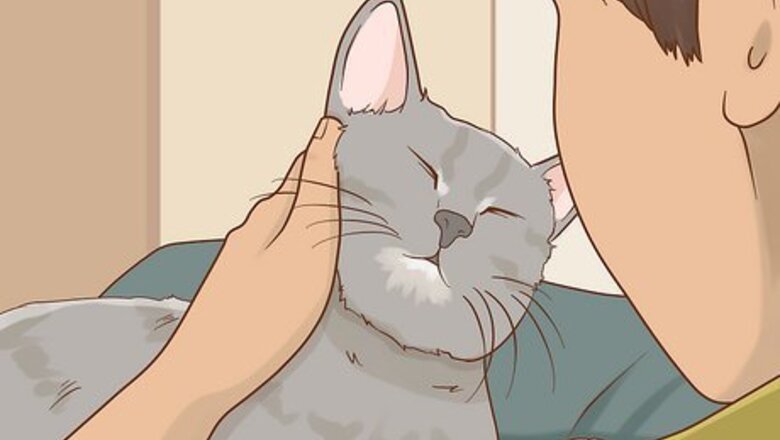
views
Choose a time when your cat is relaxed.
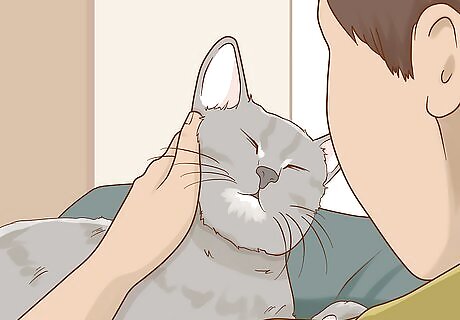
Right after your kitty’s favorite meal is a great opportunity. Cats usually aren't thrilled about getting their claws trimmed, but this doesn’t have to be a negative experience! Cats are more cooperative when they’re happy and a bit groggy, so try giving yours a big helping of their favorite wet food or a tasty treat a few minutes before you start. Post-playtime is another good option—just make sure your kitty is worn out enough to be drowsy.
Sit in a chair and put your kitty in your lap.
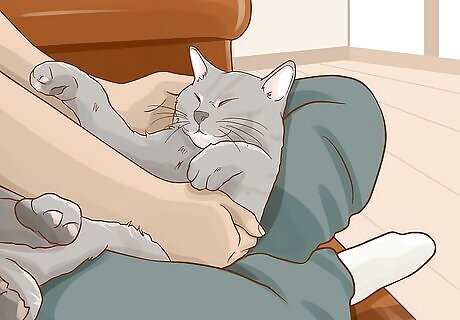
Face the cat away from you and support its body with your arm. Nestling the kitty firmly in the crook of your arm works well, just be sure to leave your dominant arm and hand free to operate the clippers. If your cat is being squirmy, enlist a friend or family member to help you hold the kitty still. If you don’t have anyone to assist you, try wrapping the kitty's body firmly in a towel with its paw extended. Face the chair away from the window, if possible. The last thing you want is for your cat to spot a bird through the window in the middle of a claw trim! If you have other pets, keep them in a separate room for now.
Pick up one paw and gently massage it.
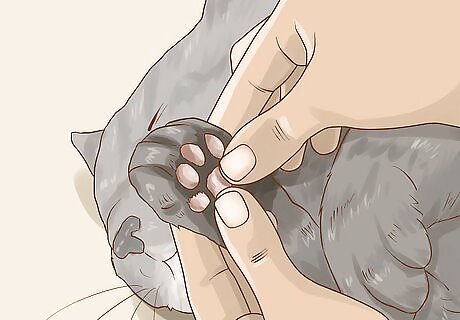
It’s usually easier to start with one of the front paws. Front paws tend to be more accessible, but it doesn’t really matter as long as you're working on one paw at a time. Hold the paw between your fingers and massage it for about 3 seconds so your cat adjusts to the feeling. Avoid massaging for more than a few seconds since most cats get impatient. If your cat is being squirmy, let them sniff the clippers. Then, give them a treat so they start associating the clippers with good things. Keep the treats nearby since you’ll probably need them again. It can also help to trim a piece of uncooked spaghetti with the clippers so your kitty can adjust to the sound.
Squeeze the paw pad until the claws extend.
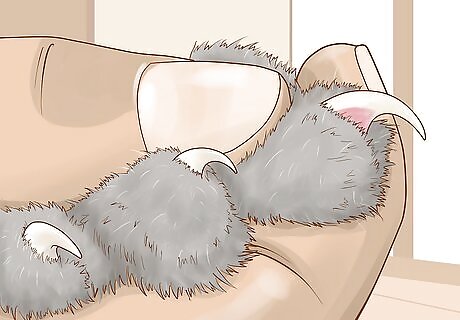
Examine the first claw closely under a light and find the pink center. This dark pink area closest to the base of the toe is called the quick. You’ll want to avoid cutting into this sensitive area since it’s a blood vessel. Get a good look at the claw and familiarize yourself with the quick’s location. It’s not the end of the world if you nick the quick, but it’ll bleed and be painful. Plus, your kitty will probably be a lot less cooperative during future trims!
Position the nail clippers sideways.
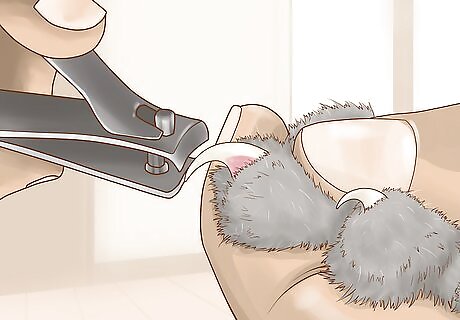
This is key when you're using human clippers on kitty claws. Turn the human clippers to the side, which is a 90-degree rotation from how you’d orient them to cut your own fingernails. If you place the flat edge of the clippers perpendicular to the extended claw, you might split the kitty’s nail.
Snip the white tip at the end of the claw.
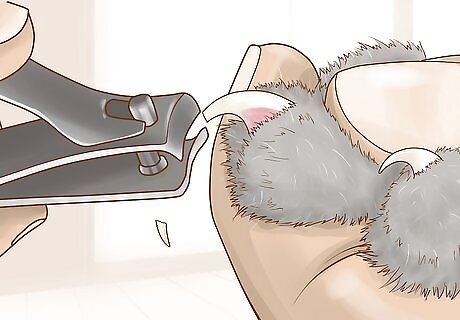
Squeeze the clipper handles and make a quick cut. Remember: anywhere in the white zone near the tip of the claw is safe! Avoid the pink area (the quick) in the center. You won’t be able to measure it exactly, but it’s best to cut about ⁄8 in (3.2 mm) before the quick. When in doubt, err on the side of caution—it's better to cut off less than more. If you accidentally cut into the quick or splinter the cat's claw, stay calm and speak to your pet in a low, soothing voice. Apply styptic powder to the nail to stop the bleeding and finish the trim another day. If you don't have styptic powder, use corn starch.
Praise your kitty and feed it a treat.
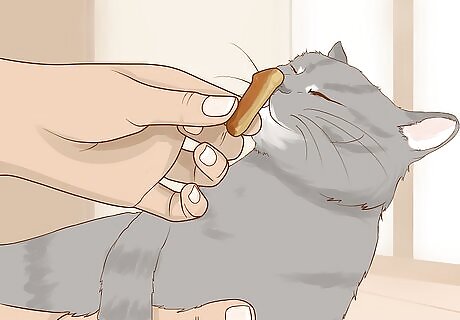
Stop and do this frequently during the first trim session. You’re essentially training your cat for future trims, so patience is key. Go slow and give your cat lots of positive reinforcement and tasty treats along way. That way, your kitty will associate nail trims with positive experiences and rewards.
Move to the next claw and snip the tip.
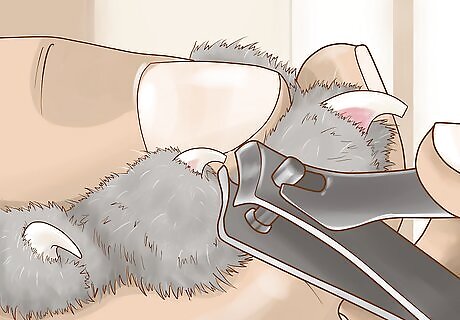
If your cat is still mellow and relaxed, keep on trimming. You probably won’t be able to trim all of your cat’s claws in a single session, which is normal and expected. A good goal for the initial session is to cut at least the first 2 claws. Then, you can tackle the remaining claws on subsequent days. If your cat is still relaxed and happy after you cut the first 2 claws, it’s fine to keep going. Every cat reacts differently.
Postpone the trim if your cat resists.
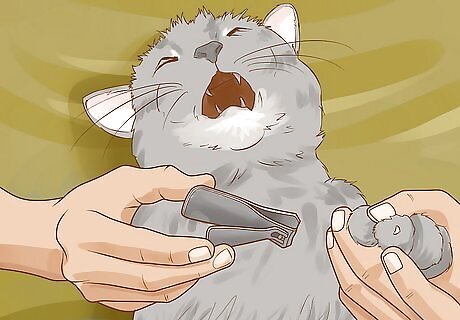
You could hurt or agitate your cat if you try to force it. A wriggly, yowling cat is tough to groom and you’ll be more likely to cut into the quick. If your cat resists, stop immediately and stay calm. Give your kitty a treat and a cuddle session and try again tomorrow. If your cat refuses to let you clip its claws, ask your vet or a groomer for help. These folks are trained and can probably show you some tricks to help you “nail” future trims on your own!
Trim your cat’s claws every 2-3 weeks.
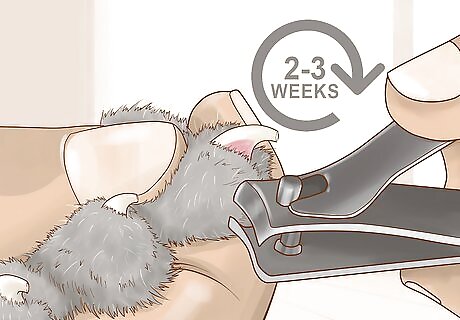
The front claws need to be trimmed more frequently than the back ones. Check your cat's front paws every 2 weeks or so and trim them once they’ve grown out. If you’re able to trim the back paws during the same session, go for it! If you can’t, the back claws can be trimmed every month or so. Growth varies depending on your cat’s breed, age, and health. Typically, senior cats will need more frequent trims than younger cats.
Provide a scratching post for your cat.
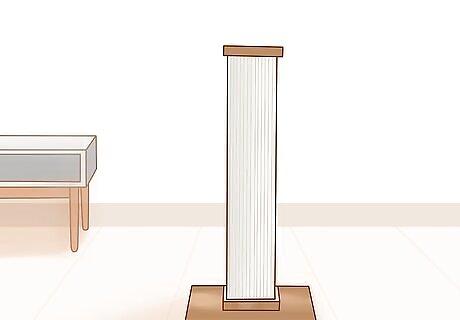
Cats love to scratch and it helps them keep their claws short. A dedicated scratching post encourages your cat to wear down its claws on its own, so you won't need to trim them as often. It can also prevent your cat from scratching up your carpets and furniture. Some cats like vertical scratching posts and others prefer horizontal scratching boxes. You may want to get one of each to help you figure out what your kitty prefers.










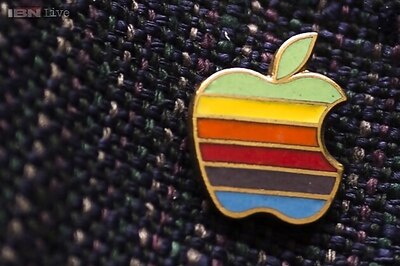








Comments
0 comment